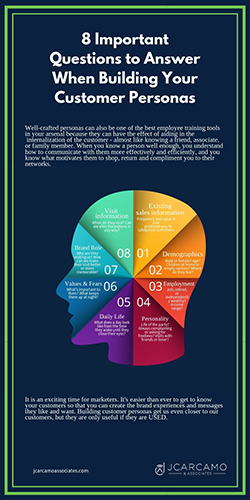Creating your brand personas can make your marketing easier.
Three key phases comprise building a strong brand: strategy, articulation, and deployment. As always, the steps you take before deployment are not only the most important but set a foundation for the brand and the business you are building.
However, the articulation stage can often include an in-depth analysis of the competition and the market but only a cursory nod to the customer and the things that both motivate and detract.
We’ve recently finished a couple of projects where we had the chance to work through buyer personas that proved to be both enlightening and somewhat fun. Understanding your customer as more than just a sale or visit pattern can help you fine-tune both your marketing and operation. Personas can help you know your customer as the multi-layered humans they are. These “pictures” of your customers are fictional, generalized representations of your customers. They help you understand them – and prospective customers – better and make it easier for you to tailor marketing efforts to the specific needs, behaviors, and concerns of different groups.
How Personas Help You
If you’re wondering why you’re not getting enough of the right customers or if you’re getting returns or complaints, a lack of clarity about your customer could be the answer. Likewise, if your marketing seems to be falling on deaf ears, it could be because you don’t have a good understanding of the customer. Moreover, understanding the customer at this level can aid in how your business expands or contracts.
Well-crafted personas can also be one of the best employee training tools in your arsenal because they can have the effect of aiding in the internalization of the customer – almost like knowing a friend, associate, or family member. When you know a person well enough, you understand how to communicate with them more effectively and efficiently, and you know what motivates them to shop, return, and compliment you to their networks.
When outlining your marketing expectations, it’s impossible to have clarity without a defined audience. I’ve mentioned before that we specialize in casino marketing. We know casinos attract all sorts of people. However, there will always exist an ideal guest that our clients hope to attract time and time again. Some ideal customers fill specific needs (i.e., Tuesday morning or Saturday nights). It is a habit for us to define the perfect customer by the amount they spend, but we also must simultaneously understand that two $100 customers can be very different in their visitation, how they shop, and how they behave. Still, many marketers continue to market to a broad range in the same way even though advances in printing and media have made it easier to do one-to-one marketing (or something very close to it).
Get to Know Your Customers
Until you undergo a persona building process, you will never truly understand the nuances of your customer base. The process will create documentation that will be useful in tailoring communications (so they resonate) or in determining the overall message, the amenities you showcase, and even in the slot titles you purchase or capital expenses you may choose to explore. A well-crafted buyer persona will shed light on
- How a customer might make decisions,
- What challenges they have to overcome,
- When, where and how they spend their time,
- When they are most prone to visit you,
- The best messages and communications channels to reach them, and more.
Consider how your business decisions, messages, and perhaps your channels might be influenced if you had this sort of knowledge.
Personas are not difficult to create
If you are a new business or a casino under construction, your persona work will more than likely have to depend on anecdotes and stories of competitor or sister properties. The most useful persona profiles, however, will be based on real customers and existing information but not on assumptions.
The strongest buyer personas are based on research and insights you gather from your database. More than likely, your company has done research. If you don’t have them now, you should get your hands on those reports. If those reports are a little dusty (from sitting on the shelf for more than 3 or 4 years), then start talking to your customers. Whether on the floor or through a simple Survey Monkey or Google Forms survey, begin asking the questions that will help you get to know your customers a little better than what you see in your weekly reports. There is also much to be gathered from tools you are already working with — such as Facebook Insights and customer comments to name two. You can upload a list to Facebook, and thanks to the information Facebook already has, your customer profiles are expanded to include income ranges, spending habits, relationship status, job titles, and more. Additionally, your CRM systems may have much more information than only the name and address.
Start with the Basics
Start with some basics and then add more detail.
- Existing sales information: What are the KPIs or your preferred way to categorize customers?
- Demographics: Male or female? Age? Children at home or empty-nesters? Where do they live?
- Employment: Job, retired, or independently wealthy? Income range?
- Casino personality (for most of our clients): Life of the party or always complaining and asking for comps? Prefers to play and go? First in line for every promotion?
- Daily life: What does a day look like from the time they wake until they close their eyes? What is challenging them every day? Who makes the entertainment/leisure decisions in the household? What influences those decisions?
- Values and or fears: What’s important to them? What keeps them up at night?
- What we add to their lives: Why are they visiting us? How can we make their visit better or more memorable?
- When do they visit? Can we alter the pattern in any way (add a day or lengthen their stay)?
For more color, you can add common complaints, real quotes and ideal marketing messages (even if the words are not an exact match to the advertising) and the channels that would reach them most efficiently and effectively.
Finally, I always recommend giving your personas names and faces to make them real to everyone. Please print them and add them to your conference room walls and time clock areas so that your customers are always front and center when you are making decisions and plans.
We have four personas for our business. We call them Mary Marketer, Vic Vendor, Jim GM, and Sally SVP. Can you guess which one I would use to describe you? Depending on your business and market, you could have as few as one or two personas, or as many as 10 or 20. That’s not including negative (or exclusionary) personas. More on that later. If you’re new to personas, start small. You can always develop more personas later if needed.
For most businesses, the Pareto Principal is relatively a given. 80% of our sales will typically come from 20% of our customers. So, my recommendation is to start with the 20%. Then, start working your way through your customer segments.
Whenever you get all of this detail down, ask yourself “why?” or challenge your assumption by asking “so what?” Avoid the temptation to take everything at face value. You have to look below the surface. You want to understand what makes each person “tick.”
Turn a Negative into a Positive
Anti-customer personas or exclusionary personas can also be of value. As Steve Jobs once alluded, that the projects Apple said no to were as crucial as the ones that received a yes. Understanding who your customer is NOT is as important as knowing you they are. Instead of casting a wide net and using valuable resources, you can focus on the customers that will grow your business (and those who will not.) Remember how Groupon was the latest and greatest? Companies offered “loss leader” offers with dramatic discounts assuming they would drive traffic, and these customers would add more to their shopping carts or orders. The trouble was, this wasn’t the case for many early participants. They didn’t understand the value-based customer wasn’t the right fit for them. The benefit of these personas is to help everyone understand the difference between a lousy fit customer and perhaps merely a demanding customer (who could still be a good fit.)
Repeat and Revisit
Each time I attend a meeting or a conference, I reevaluate my personas to ensure they are still valid or adjust as needed. As competitors enter our markets or economies start to shift, your personas will need reevaluation. Demographics and spending habits change over time. This is particularly true in industries that look to continuously fill the funnel or add new ways of creating revenue. We specialize in the casino industry. For them, the challenge of mature markets, attracting millennial customers, and adding new gaming options such as sports betting make it critical that they fully understand the target customer.
Moreover, as your business grows or adjusts, and as you get to know your customers more and more, personas should be updated. As your business progresses, you start to understand your customers better: how they respond to marketing or your environment, what enhances their visits, what makes them draw back away from you, and more.
You may even start to notice assumptions you made early on need fine-tuning. There may be new technologies or trends that are impacting the customer which should be incorporated into your personas. You may have gaps in your knowledge. for example, if you seem to be losing sales at a particular point and don’t know why revisiting your personas my hold the answer.
You may have adjusted your business since the development of the personas. Conversely, it may be your competitors who have changed and impacted your customers. Also, you cannot ignore changes in the economy or lifestyle that can shape the challenges and behaviors of your customers. All these should cue you to reevaluate your personas and ensure they are accurate portraits of your target customers.
A Word of Warning
As with many marketing tools, they are only as valuable as the use they have. So, before you start this process, you must understand how the personas will play a role in meeting your goals. For these to be actionable, they must align with your strategy. If your strategy is dependent on growth in a particular segment, start with that one first. If you are going to make changes, you have to understand the customers that are most going to be affected by those changes. Tying your personas into your business strategy is vital to turning these into useful and usable tools. Additionally, take some time to outline how these personas play a role in your departments, even those who may see themselves support departments. One technique to doing this is designing engagement scenarios for your personas to prepare your teams to interact with customers in various circumstances.
Ask yourself a few questions to understand whether or now you are creating useful persona documents.
- Are they based on customer insight or have they been created based on the opinions of an internal audience (or worse, an internal audience that never has customer contact)?
- Are they capturing the real-life experiences you are creating or only the ideal scenarios?
- Are you creating a monster one-size-fits-all persona or unique ones for separate customer segments? to be valuable personas must narrow down the pool of customers. Take a woman 56 years old in a single household and how different her motivations are from a woman 56 years old with children at home. Both are Boomers, but both very different.
- Are they being shared with all employees, or are they being held only for the eyes of the executive or marketing team?
It is an exciting time for marketers. It’s easier than ever to get to know your customers so that you can create the brand experiences and messages they like and want. Building customer personas get us even closer to our customers, but they are only useful if they are USED.




Recent Comments